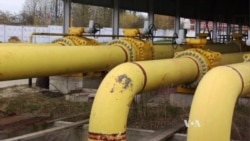As Russia continues to raise its natural gas prices to Ukraine, some people are looking to American gas as a way to ease Europe's energy dependence on Russia. But it's a solution that's still several years off.
In their home near Kyiv, Svetlana Kuleshova and Yuri Kuleshov are paying the price for more expensive Russian gas.
"It will directly affect our budget. We will simply stop buying all the things we are buying now," the pensioner explained, "because in any case we will be forced to pay the gas bill as we have to at least heat the house in order not to freeze. We will start looking for alternatives, of course."
Their worry is familiar to many Europeans. Ukraine and six other European countries get all their gas from Russia.
Meanwhile, threats of Western economic sanctions against Russia have been shrugged off. Russia's First Deputy Prime Minister Igor Shuvalov says Moscow can find other places to sell its gas and that will cost Europe even more.
"It will force Europeans to invest in new infrastructure to buy gas from the United States and other parts of the world. You will pay for this more," noted Shuvalov. "It will mean that the consumers will pay more, but Russian gas will be consumed by someone else in other regions of the world."
Problem solved?
American natural gas, flowing through terminals located in various locations including the Eastern U.S. state of Maryland, could help solve the problem...but not yet.
A new section of the plant to enable the Maryland facility to liquefy natural gas and ship it overseas won't be ready until late 2017. Other plants being built are on a similar timeline.
And when it does open, the terminal will send all its gas to India and Japan.
Energy expert Paul Bledsoe, a senior fellow at the German Marshall Fund of the United States, says the U.S. will not be Europe's first new source of gas.
"The first places are going to be a southern pipeline from Central Asia, from North Africa and from their own resources," Bledsoe explained. "What we're talking about, though, is broadening the available resources globally for gas generally, essentially globalizing the natural gas market."
Bledsoe says Washington should expedite applications by European countries to import U.S. gas and help Europe develop its own gas from shale gas.
"What we're really calling for is a joint U.S.-EU plan on natural gas, to diversify the sources of gas for Europe, to reduce long-term prices, to cut emissions and cut dependence on Russia. There's a tremendous opportunity here," he said.
When that happens, both Europe and America will benefit, according to energy writer and professor Steve LeVine.
"The impact of putting [exporting] all this gas, and the signal that it's sending, is going to be to increase U.S. influence in the world, geopolitical influence from this natural gas," he said.
Russian President Vladimir Putin, according to LeVine, will then have to sell natural gas to China, which will insist on a lower price.
In their home near Kyiv, Svetlana Kuleshova and Yuri Kuleshov are paying the price for more expensive Russian gas.
"It will directly affect our budget. We will simply stop buying all the things we are buying now," the pensioner explained, "because in any case we will be forced to pay the gas bill as we have to at least heat the house in order not to freeze. We will start looking for alternatives, of course."
Their worry is familiar to many Europeans. Ukraine and six other European countries get all their gas from Russia.
Meanwhile, threats of Western economic sanctions against Russia have been shrugged off. Russia's First Deputy Prime Minister Igor Shuvalov says Moscow can find other places to sell its gas and that will cost Europe even more.
"It will force Europeans to invest in new infrastructure to buy gas from the United States and other parts of the world. You will pay for this more," noted Shuvalov. "It will mean that the consumers will pay more, but Russian gas will be consumed by someone else in other regions of the world."
Problem solved?
American natural gas, flowing through terminals located in various locations including the Eastern U.S. state of Maryland, could help solve the problem...but not yet.
A new section of the plant to enable the Maryland facility to liquefy natural gas and ship it overseas won't be ready until late 2017. Other plants being built are on a similar timeline.
And when it does open, the terminal will send all its gas to India and Japan.
Energy expert Paul Bledsoe, a senior fellow at the German Marshall Fund of the United States, says the U.S. will not be Europe's first new source of gas.
"The first places are going to be a southern pipeline from Central Asia, from North Africa and from their own resources," Bledsoe explained. "What we're talking about, though, is broadening the available resources globally for gas generally, essentially globalizing the natural gas market."
Bledsoe says Washington should expedite applications by European countries to import U.S. gas and help Europe develop its own gas from shale gas.
"What we're really calling for is a joint U.S.-EU plan on natural gas, to diversify the sources of gas for Europe, to reduce long-term prices, to cut emissions and cut dependence on Russia. There's a tremendous opportunity here," he said.
When that happens, both Europe and America will benefit, according to energy writer and professor Steve LeVine.
"The impact of putting [exporting] all this gas, and the signal that it's sending, is going to be to increase U.S. influence in the world, geopolitical influence from this natural gas," he said.
Russian President Vladimir Putin, according to LeVine, will then have to sell natural gas to China, which will insist on a lower price.








